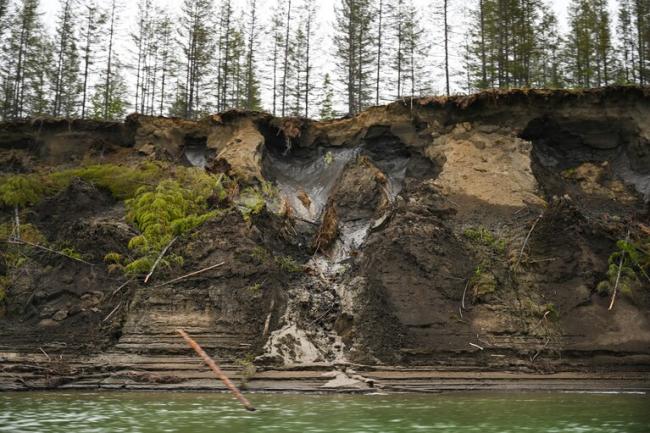Articles Menu

Aug. 2, 2021
Scientists have long been worried about what many call “the methane bomb” — the potentially catastrophic release of methane from thawing wetlands in Siberia’s permafrost.
But now a study by three geologists says that a heat wave in 2020 has revealed a surge in methane emissions “potentially in much higher amounts” from a different source: thawing rock formations in the Arctic permafrost.
The study was published by the Proceedings of the National Academy of Sciences.
Surface temperatures during the heat wave in 2020 soared to 10.8 degrees Fahrenheit above the 1979-2000 norms. In the long stripes, there is hardly any soil, and vegetation is scarce, the study says. So the limestone crops out of the surface. As the rock formations warm up, cracks and pockets opened up, releasing methane that had been trapped inside.
The concentrations of methane were elevated by about 5 percent, Froitzheim said. Further tests showed the continued concentration of methane through the spring of 2021 despite the return of low temperatures and snow in the region.
“We would have expected elevated methane in areas with wetlands,” Froitzheim said. “But these were not over wetlands but on limestone outcrops. There is very little soil in these. It was really a surprising signal from hard rock, not wetlands.”
“It’s intriguing. It’s not good news if it’s right,” said Robert Max Holmes, a senior scientist at the Woodwell Climate Research Center. “Nobody wants to see more potentially nasty feedbacks and this is potentially one.”
“What we do know with quite a lot of confidence is how much carbon is locked up in the permafrost. It’s a big number and as the Earth warms and permafrost thaws, that ancient organic matter is available to microbes for microbial processes and that releases CO2 and methane,” Holmes said. “If something in the Arctic is going to keep me up at night that’s still what it is.” But he said the paper warranted further study.
The geologists who wrote the report usually study things such as tectonic plate boundaries and the way those geologic plates fold over one another. But they have worked in the Arctic and that has piqued their interest.
The biggest sources of methane in the world are agricultural, such as rice growing, and leaks and flares from oil and gas operations, such as in the U.S. Permian Basin in Texas and New Mexico where production has soared in the past decade. But Froitzheim said that in the permafrost “the question is: how much will come, and we don’t really know.”
Normally the frozen permafrost acts as a cap, sealing methane below. It also can lock up gas hydrates, which are crystalline solids of frozen water that contain huge amounts of methane. Unstable at normal sea-level pressure and temperatures, gas hydrates can be dangerously explosive as temperatures rise.
The study said that gas hydrates in the Earth’s permafrost are estimated to contain 20 gigatons of carbon. That’s a small percentage of all carbon trapped in the permafrost, but the continued warming of gas hydrates could cause disruptive and rapid releases of methane from rock outcrops.
“It will be important to continue to compare methane in future years to really pinpoint how much additional geologic methane is being emitted to the atmosphere as the permafrost thaws," said Ted Schuur, professor of ecosystem ecology at Northern Arizona University. “We know the heat wave was real, but whether it triggered the methane release cannot be determined without additional years of methane data."
The Arctic has also delivered other sobering news. Polar Portal, a website where Danish Arctic research institutions present updated information about ice, said last week that a “massive melting event” had been big enough to cover Florida with two inches of water.
An earlier version of this article used the former name of the Woodell Climate Research Center, which changed its name from the Woods Hole Research Center in 2020.
[Top photo: Permafrost, seen at the top of the cliff, melts into the Kolyma River outside of Zyryanka, Russia, in July 2019. A new study has found that methane is being released not only from thawing wetlands but also from thawing limestone. (Michael Robinson Chavez/The Washington Post)]

